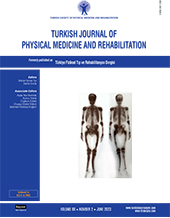Can trunk control scales differentiate for dependent and independent ambulation in ischemic stroke patients?
2 Akdeniz University, Faculty of Health Sciences, Antalya, Türkiye
3 Department of Neurology, Health Science University, Antalya Training and Research Hospital, Antalya, Türkiye
4 Private Artrolife Clinic, Physical Medicine and Rehabilitation, Antalya, Türkiye DOI : 10.5606/tftrd.2023.10773 Objectives: This study aimed to compare the ability of trunk control scales (TCSs) to distinguish independent ambulation and investigate whether there was a relationship between TCSs and activities of daily living in patients with stroke.
Patients and methods: The prospective, cross-sectional study was conducted with a total of 126 patients (52 females, 74 males; mean age: 64.9±10.7 years; range, 40 to 88 years) between August 2018 and January 2020. According to their ability to walk 10 m, the patients were divided into three groups: the nonambulatory group (Group 1, n=31), those who required an assistive device while walking (Group 2, n=35), and those who could walk independently (Group 3, n=60). The Stroke Rehabilitation Assessment of Movement Instrument (STREAM), Postural Assessment Scale for Stroke Patients Scale (PASS), Trunk Impairment Scale, Trunk Recovery Scale, Trunk Control Test, and Modified Barthel Index (MBI) were used to determine the relationship between TCSs and activities of daily living.
Results: The median TCS scores differed between the groups; the lowest score was of Group 1, and the highest score was of Group 3 (p<0.05). The MBI was found to be correlated with all dimensions of STREAM in Group 1 and all dimensions of PASS in Group 2 (correlation coefficient was between 0.50 and 0.69).
Conclusion: All TCSs could distinguish ambulatory and nonambulatory patients. The STREAM and PASS correlated the most with MBI in Groups 1 and 2, respectively.
Keywords : Ambulation, Barthel index, stroke, trunk control

















